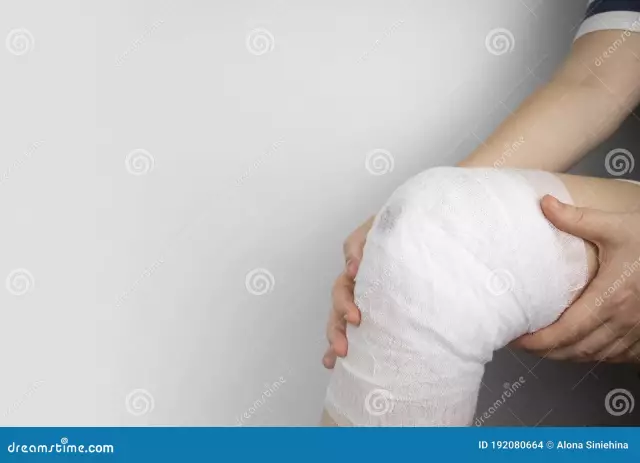- Author Curtis Blomfield [email protected].
- Public 2023-12-16 20:44.
- Last modified 2025-01-23 17:01.
Plaster bandage is a special bandage made from calcium sulfate hemihydrate and high quality cotton. It is used in traumatology and orthopedics for fixation of bone fractures, immobilization of joints. With a plaster bandage, you can fix almost any part of the body.

Cast bandages have been widely used since the 1970s as a support to immobilize broken bones. A gauze cloth impregnated with gypsum is dipped into water. Then they are taken out and wrapped around the broken limb. When dried, a strong so-called bandage is formed. The plaster cast immobilizes the limbs while the bones heal.
A plaster bandage is worn for approximately 6 to 8 weeks. Sometimes the duration of being in a cast can be longer or shorter - depending on the severity and location of the fracture.
Application

The main purpose of using a plaster bandage is to fix fragments of bones and joints. A plaster bandage is applied in the following cases:
- joint immobilization in case of ligament injury, joint swelling due todisease;
- tear tendon;
- fractures, bruises, cracks, sprains;
- bone surgery (osteotomy);
- difficult wounds;
- children's orthopedics (congenital clubfoot, hip dislocation);
- manufacture of orthopedic appliances.
Production
The fixation bandage can be made by hand or bought ready-made at the pharmacy.

The process of making a plaster bandage is as follows:
- Anhydrous calcium sulfate (gypsum) is gradually and evenly applied to the surface of dry cotton gauze 500 cm long and 15 cm wide.
- Applied gypsum is rubbed into gauze. The excess is removed.
- The bandage is rolled up and stored in a dry place.
Overlay process
To apply a cast, you should contact a medical institution. But in the absence of such an opportunity, a fixing bandage can be made at home.

How to apply a plaster bandage? The process consists of several stages. You will need a medical plaster bandage, cotton wool, bandages, scissors and warm water:
- First you need to clean the skin. If there are wounds, apply bandages from the bandage, avoiding the appearance of wrinkles.
- Bony prominences such as knee, elbow, ankle are covered with an even layer of cotton.
- Gypsum roll is soaked in a bucket (basin) in water at room temperature. Hot water is not recommended. The heat generated when the plaster sets can burn the skin. When they stopair bubbles form, the bandage is completely soaked and ready for use.
- Gently lift the ends of the bandage with both hands, squeezing lightly without twisting.
- When applying a plaster bandage, keep the corresponding part of the body in a stable position. Work quickly, without interruptions. Apply each layer evenly on top of each other, smoothing out the wrinkles. The previous layer of bandage is overlapped by about half the width.
- The dressing is also applied above and below the fracture site.
- The plaster bandage dries in about 25 minutes. Full solidification will occur after 24 hours. During this time, it is not recommended to physically influence the fixed area.
Bandage care
After applying a plaster bandage, you should follow some rules:

- Avoid getting water on the cast. When taking a shower, you must cover the cast with cellophane.
- Do not scratch the skin under the cast with a sharp or blunt object, as this can damage the skin and cause infection.
- When a leg is broken, one should not step on a fixed limb. Better to use crutches.
- Do not remove the cast without the doctor's permission.
Seek medical attention if you experience the following symptoms:
- wetting the cast, cracking or breaking;
- appearance of increasing pain despite taking painkillers;
- changing skin color fixedlimbs;
- numbness or tingling in limbs;
- inability to move fingers;
- the appearance of an unpleasant odor.
Bandage removal

After the plaster bandage is removed, there may be some stiffness and weakness in the limb. Sometimes physical therapy may be needed for recovery. It includes exercises to improve joint mobility, maintain balance, and prevent muscle atrophy. After removing the plaster bandage, it is recommended to protect the broken bone for about a month.
Skin may appear slightly paler than normal. This will pass after a while.






